How to Plant, Grow, and Care for ‘King Tut’ Grass
‘King Tut’ grass is a unique tropical plant with a storied history. These plants are striking additions to annual planters, bog gardens, and indoors as houseplants. In this article, garden expert Christina Conner outlines how to care for these beautiful plants.

Contents
‘King Tut’ grass is nicknamed the “umbrella plant” for its long stalks (called culms) topped with umbellates resembling umbrellas. It’s a dwarf variety of the Cyperus papyrus species, commonly known as papyrus. That’s right – the same papyrus as the paper.
The straight species grows very tall, so this cultivar is most popular for the ornamental garden, which has a maximum height of six feet. This striking tropical species is common in bog gardens or ponds. Some cultivars may even be kept as houseplants. An added bonus for the at-home florist: their tall umbellate culms look fabulous in cut flower arrangements.
Cyperus papyrus ‘King Tut’ is a trademarked species developed by Proven Winners for their Graceful Grasses series. Though it looks much like it, botanically, it’s not considered a grass but is a sedge, a group of grass-like plants. Similar cultivars and species include Cyperus haspan, Cyperus alternifolius, Cyperus isocladus, Cyperus papyrus ‘Dwarf Papyrus,’ and ‘Nanus.’
‘King Tut’ Grass Overview
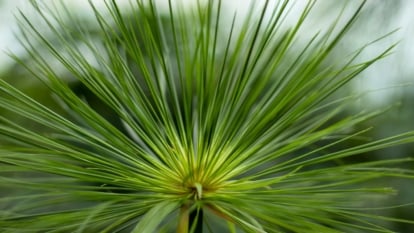
|
Plant Type
Aquatic perennial
Family
Cyperaceae
Genus
Cyperus
Species
papyrus
|
Native Area
Africa, the Mediterranean
Exposure
Full sun to partial shade
Height
4-6 feet
Watering Requirements
High
|
Pests & Diseases
Rust, gnats, no serious issues
Maintenance
Minimal to none
Soil Type
Loam, chalk, clay, sand
Hardiness Zone
USDA 10-11
|
What Is It?
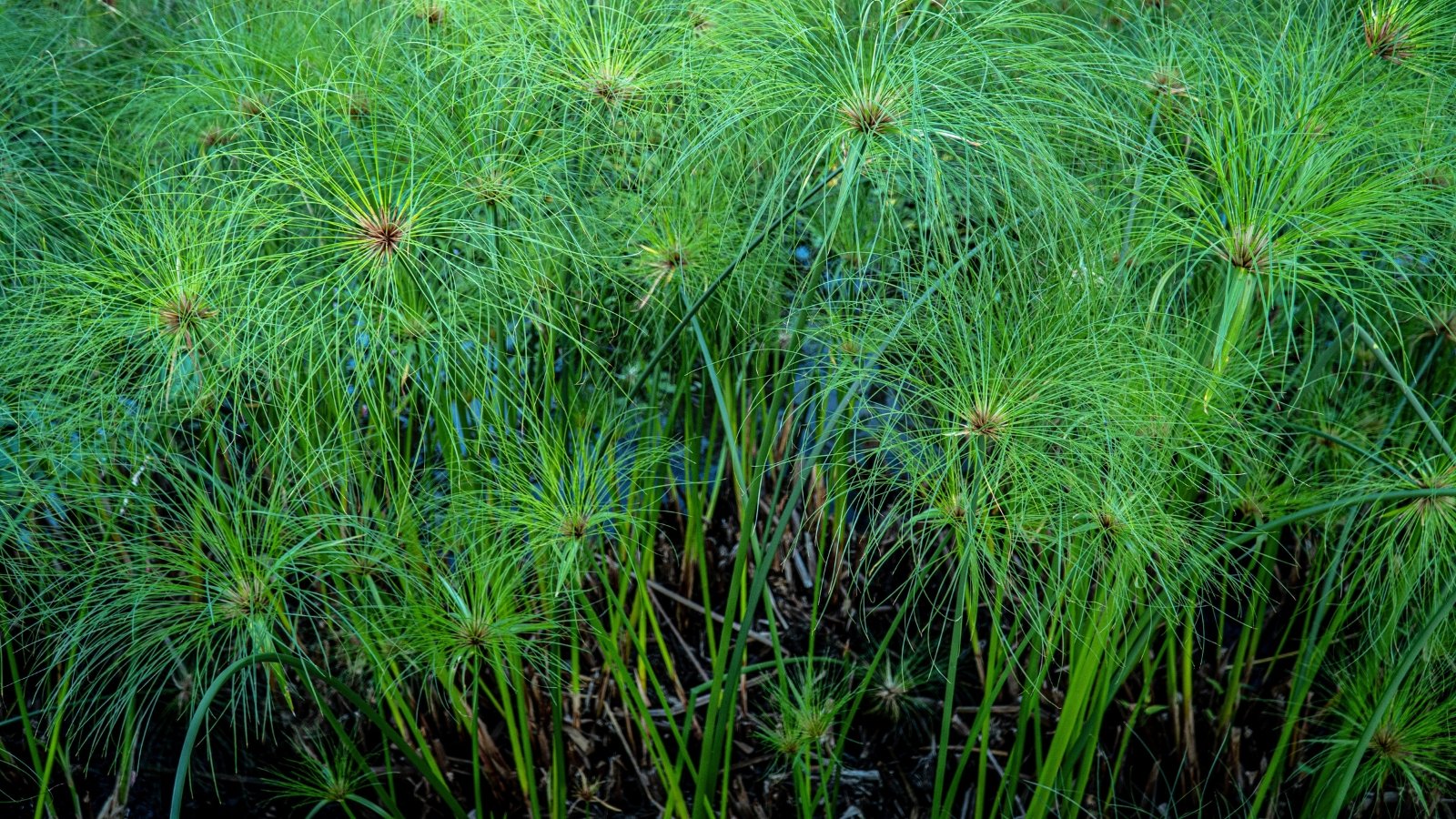
Today, most Papyrus species on the market are sold as ornamentals. But papyrus has a rich history of use in medicine, boatbuilding, clothing, and, most notably, being used as paper. Nearly 5,000 years ago, ancient Egyptians used this plant to create written records.
Papyrus was central to ancient Egyptian mythology and their belief in the creation of the universe. The Egyptians recognized the fertility of papyrus marshes, and their importance was depicted in their artwork and architecture. In the Egyptian myth of the goddess Isis and her son Horus, papyrus thickets protected him from his murderous uncle, Osiris. As a history nerd, seeing my papyrus plant is a reminder of its ancient origins.
Characteristics
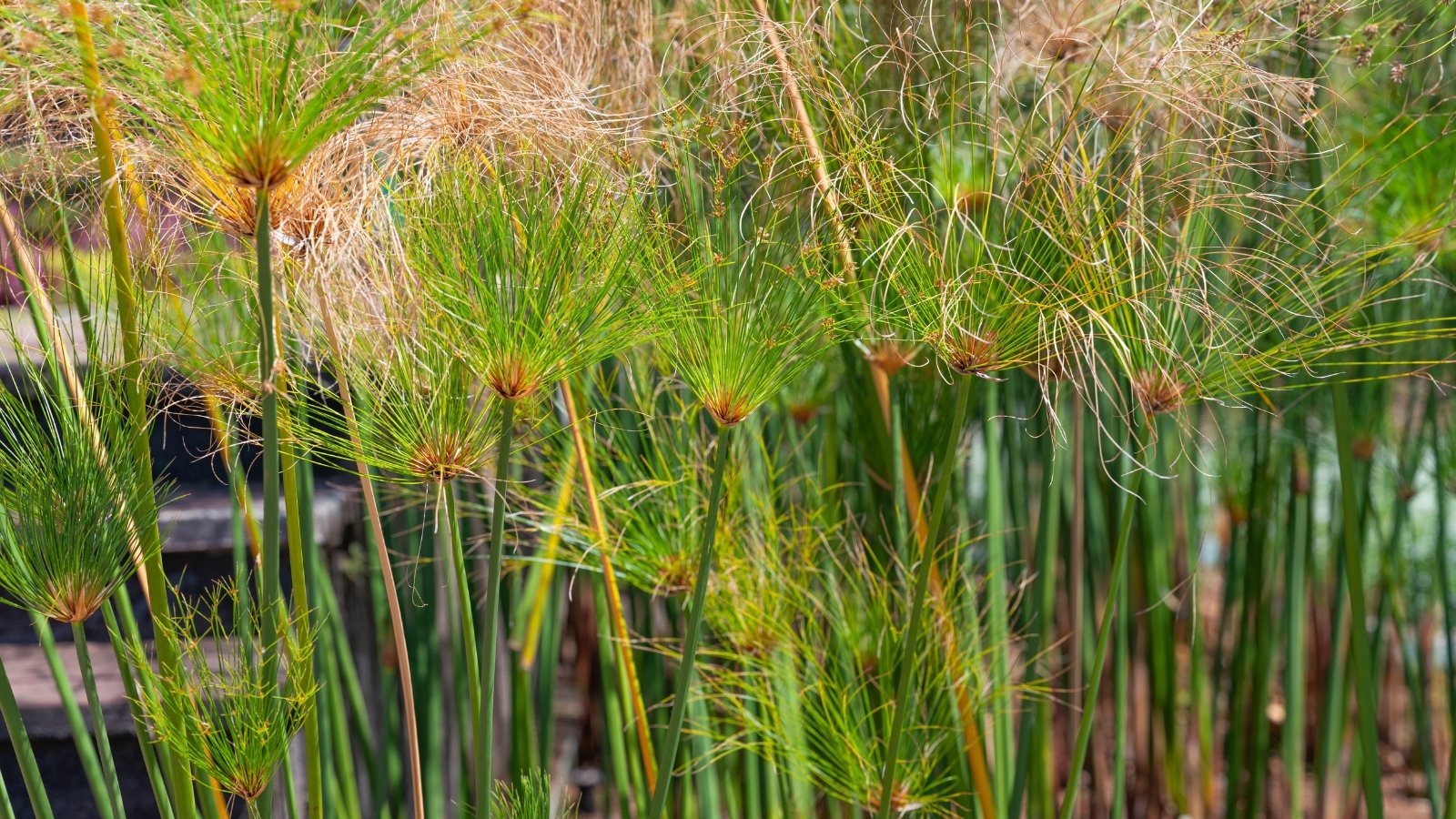
Like other members of the Cyperus family, it has tall triangular stems topped with tufts of umbellate foliage. It does flower with small, brownish-green flowers and eventually produces small nut-like fruits. That said, their green foliage is the main attraction.
They’ve been cultivated for ornamental use and grow two to four feet tall. In its native zones in Africa along the Nile River and in the Mediterranean, the species grows up to 16 feet tall.
Native Area
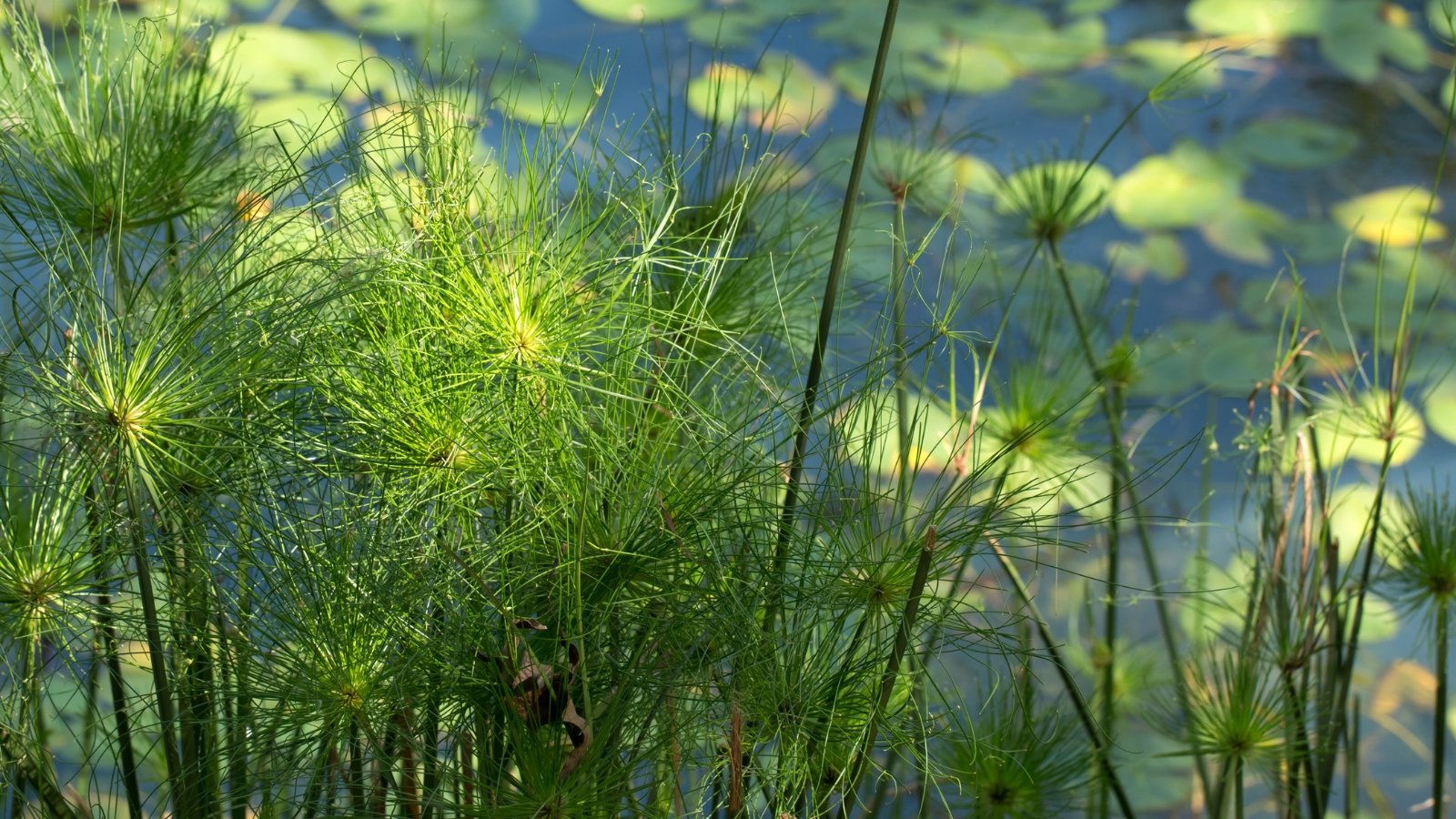
Native to Africa, this decorative grass originated along the streambanks of the White Nile in Sudan. It was grown en masse for cultivation in the Nile Delta of Egypt. It was so useful that it was introduced to regions across the world: the Middle East, Southern Africa, Europe, and later, North America and Australasia. Today, it grows in African swamps, shallow lakes, and stream banks.
This sedge is invasive and outcompetes native aquatic plants in sensitive waterways. In California, Florida, Louisiana, and Hawaii, please avoid growing it and its associated cultivars, as it is classed as an invasive species there.
Planting
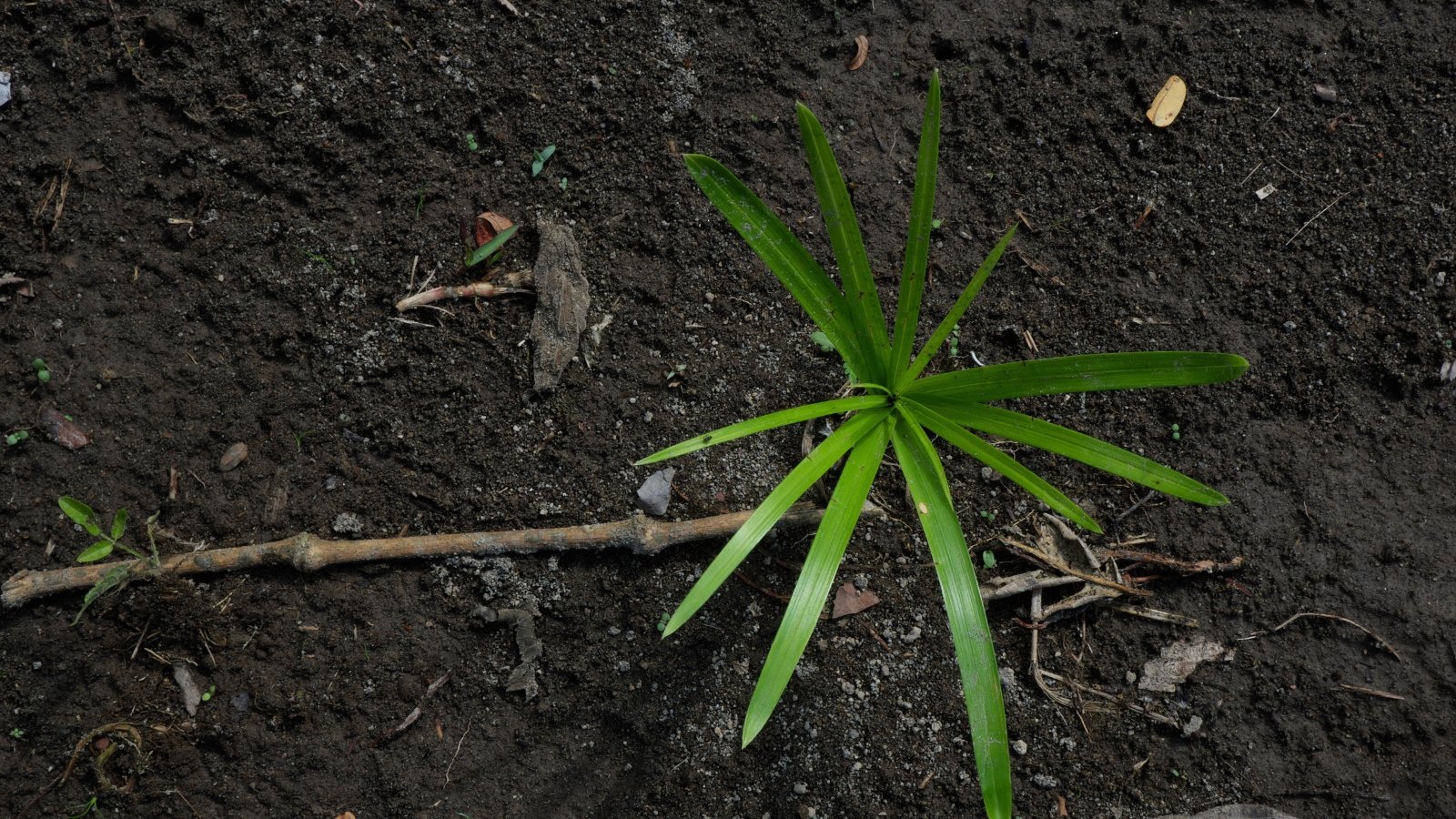
Only perennial in warm climates, this sedge is an annual in outdoor plantings or as a houseplant. Adaptable to full sun or partial shade, the only requirement is ample water. Grow in containers, in the ground, or even in water.
‘King Tut’ works as a thriller alongside vining and mid-height annuals. It can grow up to four feet tall, so keep it in the back or in the center of flower beds and containers Even on its own or in groups, it’s a statement maker.
Transplanting
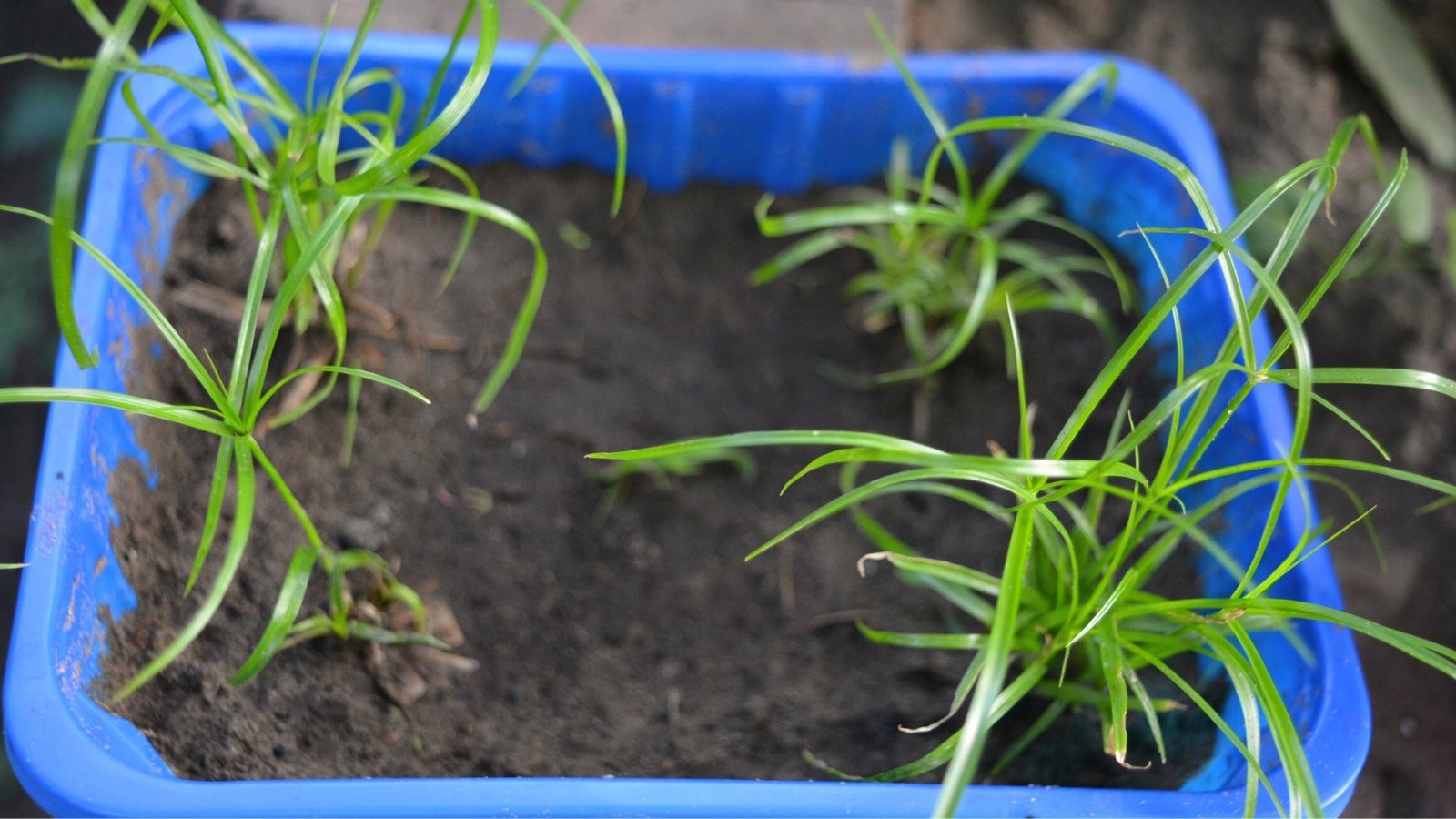
Your new papyrus sedge will likely be potbound and need to have its roots worked out of its grower’s pot. Tease their roots and use a hori hori to gently score the sides of the plant if the roots are circling around the pot. Then, repot into a larger container or in the ground. If you’re growing multiple plants, space them three to four feet apart. This may seem like a lot for small plants, but they’ll grow!
How to Grow
This is an exceptionally easy ornamental to grow when its water and temperature requirements are met. It certainly prefers being grown outdoors, but you can overwinter it indoors in a bright, sunny spot.
Light
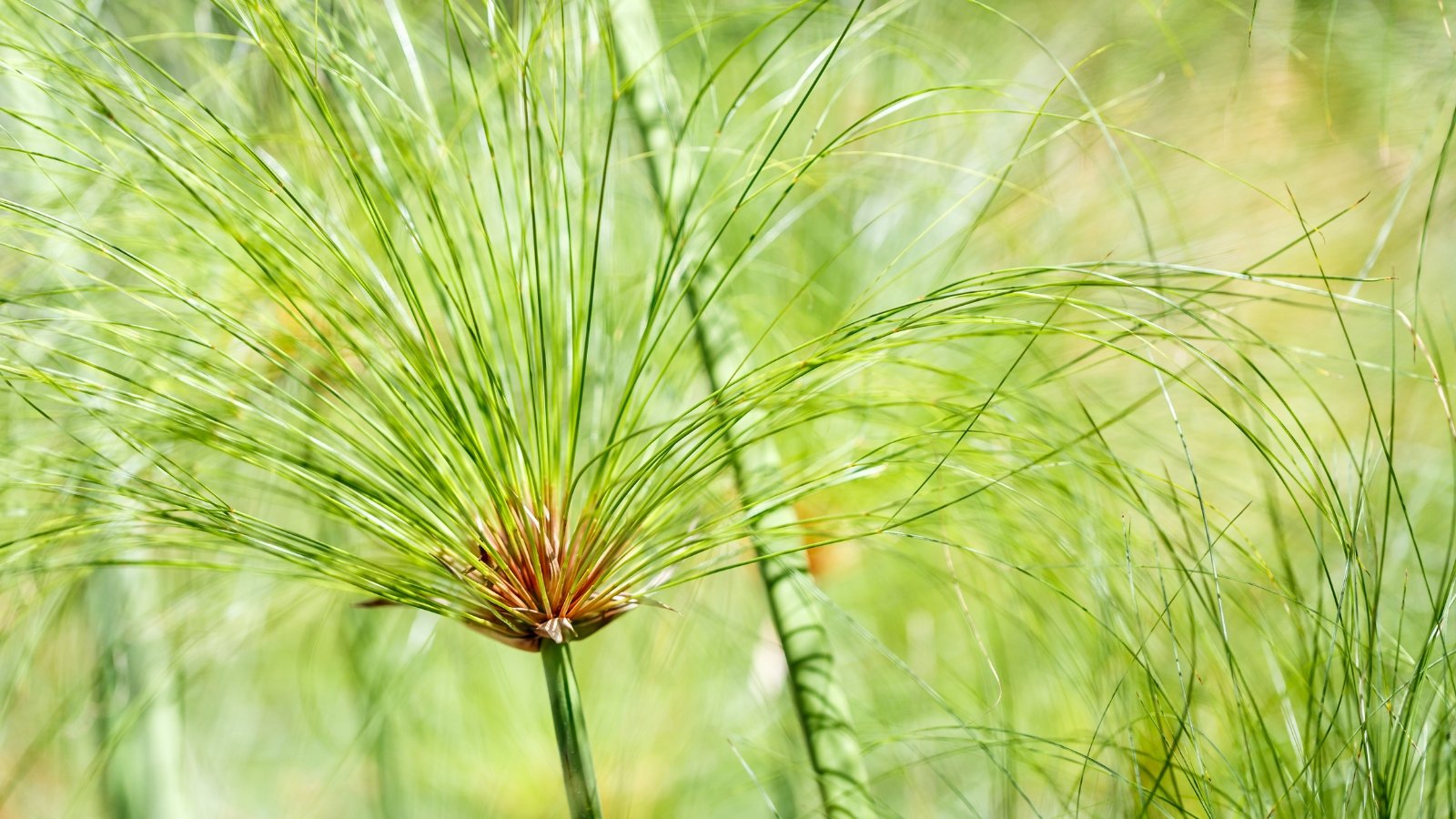
‘King Tut’ handles full sun to partial shade and is more tolerant of shade than the straight species. If in partial shade, it should receive morning sun with afternoon shade. If in full sun, it’s vital to keep the soil moist to prevent ]it from burning under harsh afternoon sunlight.
Water

A thirsty plant native to streambanks, it does best in boggy conditions. The more sun this it has, the greater its water requirements. In partial sun, it’s more forgiving to occasional dryness. This is perfect as a pond plant as long as the crown is kept above the surface.
It’s so thirsty that drainage holes aren’t necessary. This is a great plant for repurposing vessels or using pots without drainage holes. Due to its ability to rapidly spread, growing in containers is most likely favorable for most gardens.
Soil

Beyond being wet, this soil is adaptable to most soil types. The soil should also be fertile and rich in organic matter, similar to what would be found in its native habitat. Try adding manure or compost to your soil.
Building your soil doesn’t need to be costly, either. There are plenty of free ways to improve soil health!
Temperature and Humidity
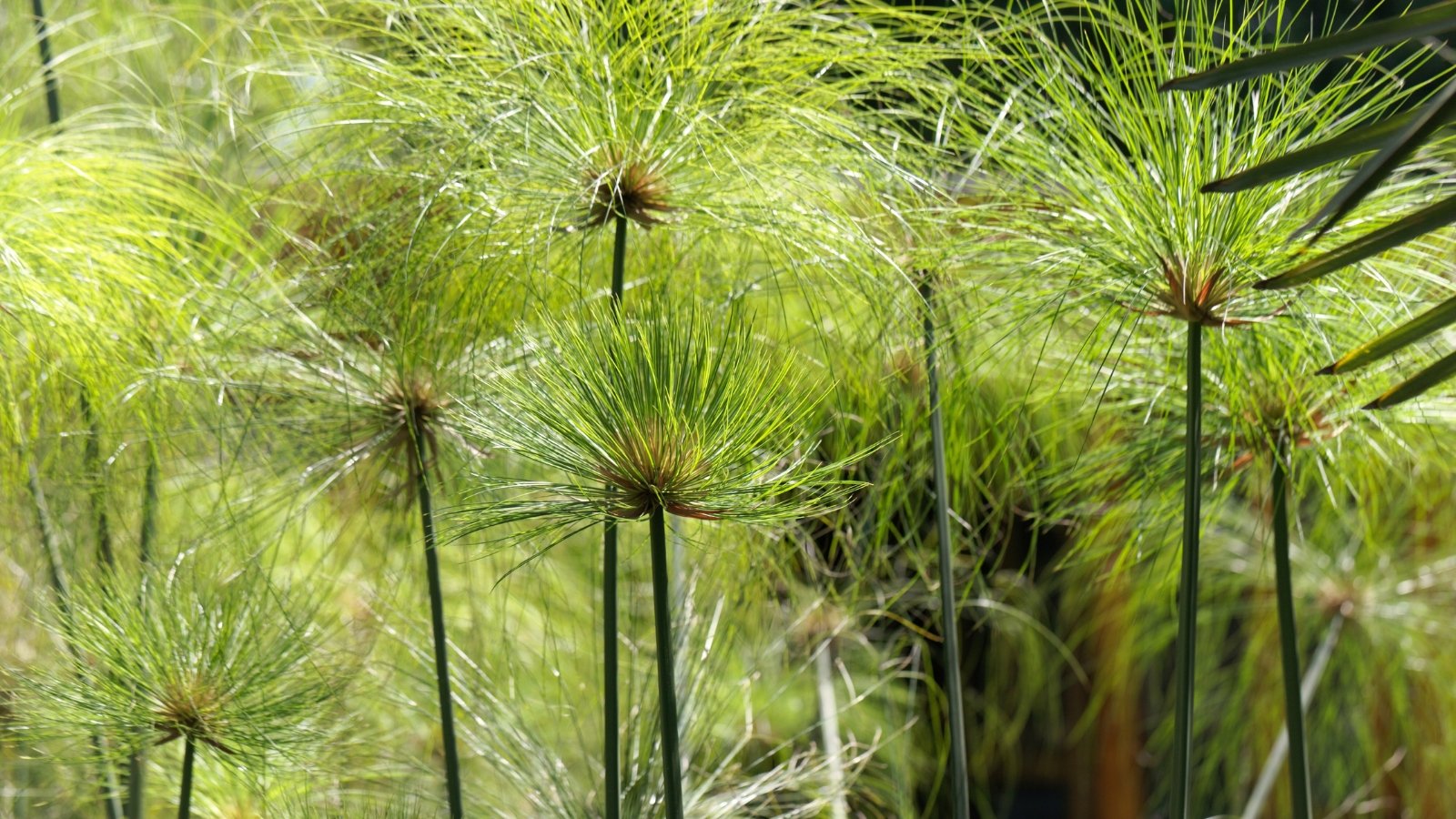
Ornamental Cyperus species need warm temperatures to thrive, so this plant is only perennial in USDA zones 10-11, where temperatures never drop below 40°F (4°C).
Use their native tropical habitat as a guide for how to keep this plant. They thrive in hot, humid tropical conditions. If you don’t live in the tropics, you can easily overwinter this plant.
Fertilizing

This plant isn’t a heavy feeder, but an occasional dose of fertilizer keeps this sedge happy and healthy. In an aquatic setting, an aquatic plant fertilizer gives the plant a boost. In the ground or in containers, balanced or nitrogen-rich organic fertilizer such as fish emulsion provides the plant and those surrounding it with much-needed nutrients.
Maintenance

Cyperus papyrus is a fast and somewhat aggressive grower and quickly becomes potbound. To keep the plant healthy, bump it up to a larger pot or divide it. As the culms (the plant’s stems) age, they turn brown and die. Cut these down to the rhizome.
Besides occasional pruning and fertilization, it doesn’t require much upkeep. Overall, it’s a pretty low-maintenance plant.
Propagation

Propagating Cyperus papyrus ‘King Tut’ is illegal because the plant is trademarked by Proven Winners. Therefore, grow it and enjoy it, but don’t propagate it.
Popular Varieties
Cyperus papyrus ‘Prince Tut’
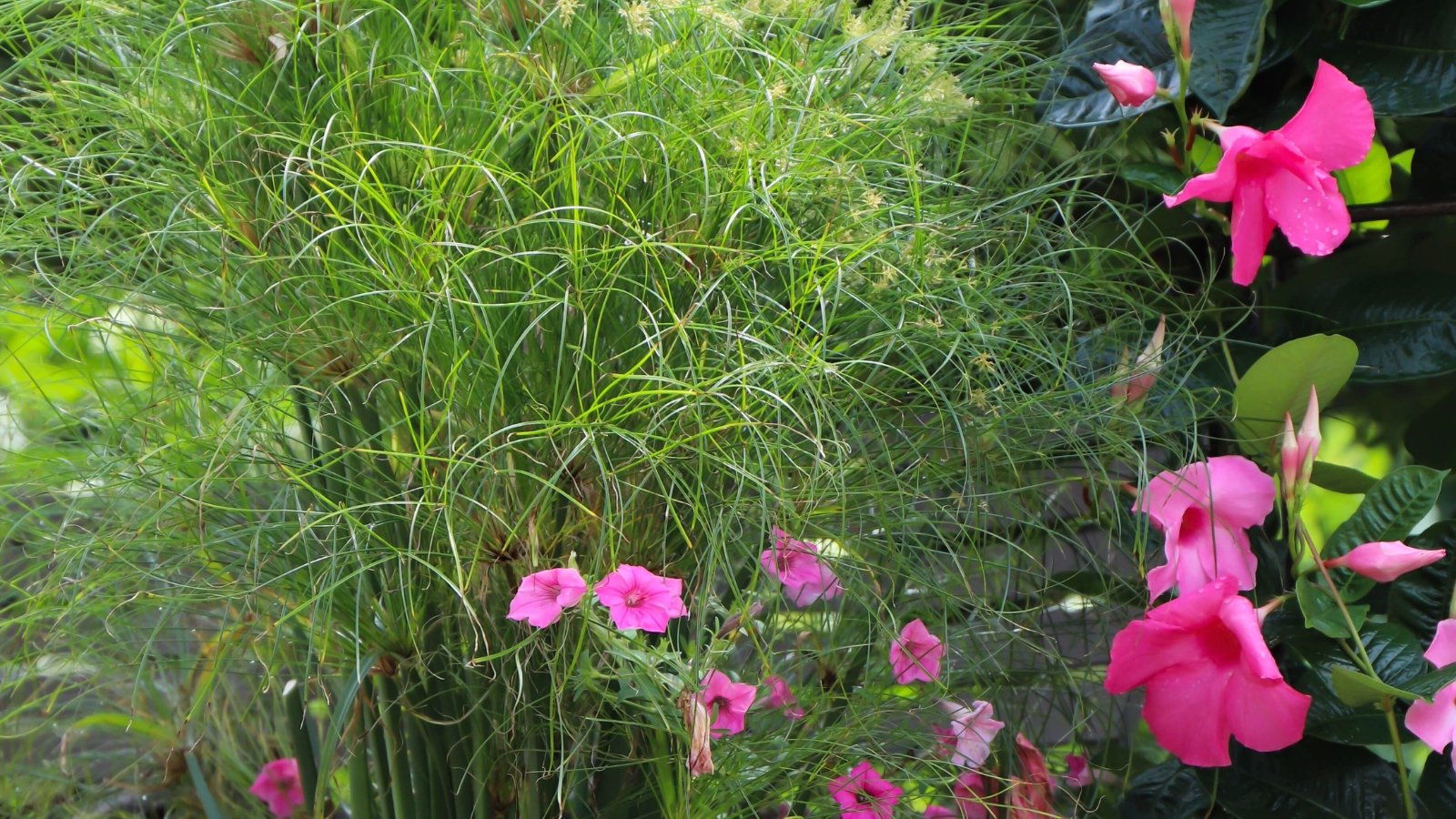
Another variety developed by Proven Winners, ‘Prince Tut’ is about half the size of ‘King Tut.’ This plant only grows to two to three feet tall and is sturdier and stockier. It has the same growth requirements as its older brother but is a more compact plant.
Cyperus prolifer ‘Queen Tut’
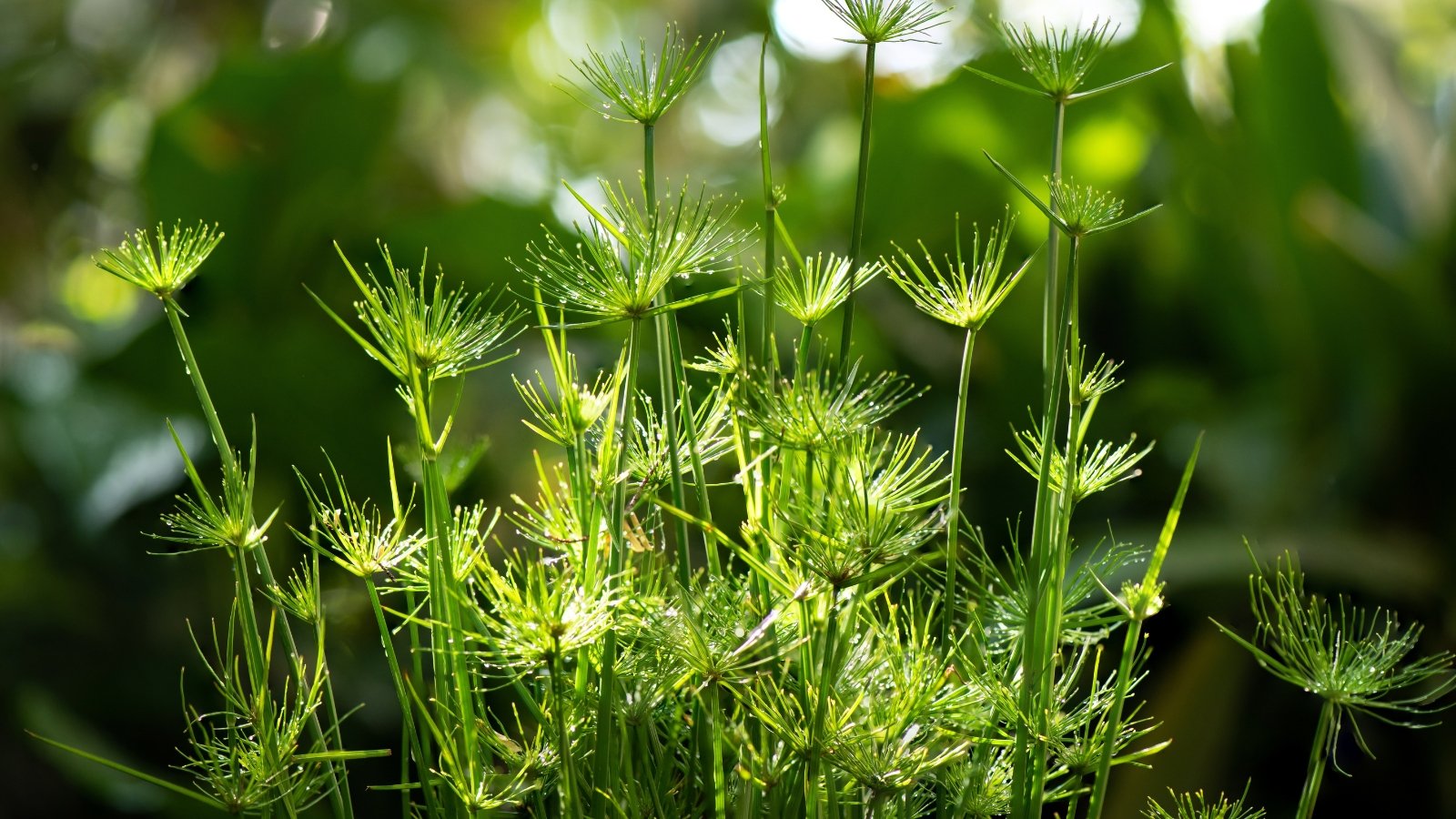
Also in the Proven Winners’ Graceful Grasses series is ‘Queen Tut’, the smallest papyrus species in the series, along with ‘Baby Tut.’ This variety is hardy to USDA zone 9 and tops out at just two feet tall. Unlike ‘King Tut,’ this plant dislikes overwintering indoors, so it’s best as an annual or perennial in tropical climates.
Cyperus alternifolius ‘Baby Tut’
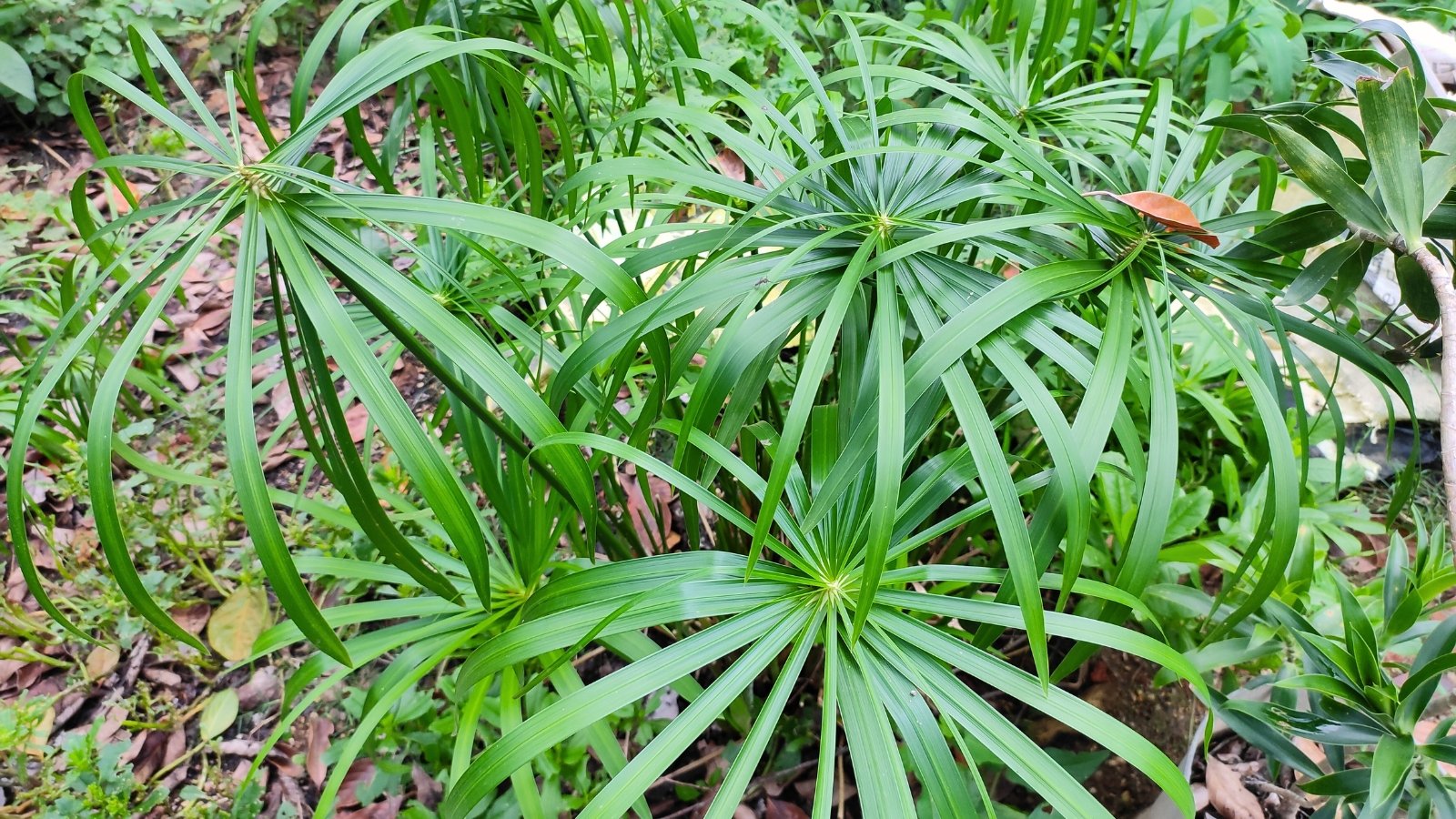
Known as umbrella grass or umbrella palm, this plant grows up to two feet. It has glossier leaves and the same umbrella shape as ‘King Tut.’ One other cool part about this plant is that it filters pollutants like copper and manganese from soil.
Common Problems
They’re invasive in warm climates and have escaped cultivation in Florida, California, Louisiana, and Hawaii, leading to waterway damage. Take care to contain this plant in tropical climates. They’re not prone to disease but are very sensitive to cold temperatures – these plants should never experience temperatures below 40°F (4°C).
Pests
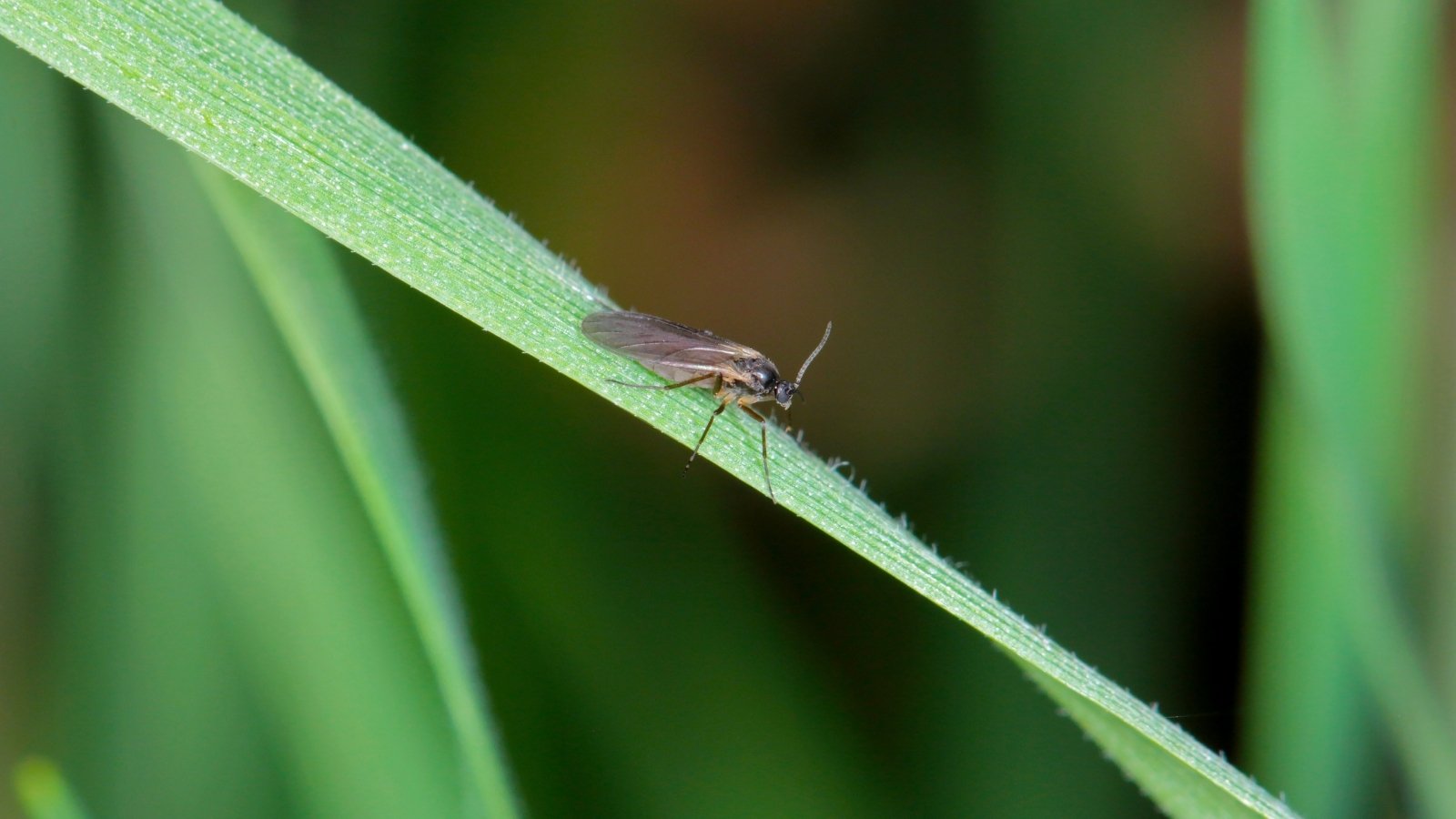
There aren’t many pests that favor Cyperus plants, but wet soil may promote the presence of fungus gnats. These insects are annoying but not harmful to plants. Treat these pests with hydrogen peroxide or neem oil.
Diseases

This sedge isn’t susceptible to many diseases, but some gardeners have noticed rust fungus on their plants. Keeping their leaves dry is a good way to prevent this fungus. Cut off and dispose of any culms with discoloration to prevent spread.
Frequently Asked Questions
Is ‘King Tut’ grass safe for pets?
Cyperus papyrus is non-toxic for both cats and dogs. Their starchy rhizomes are even edible for humans.
How do you overwinter ‘King Tut’ grass?
If you don’t live in a tropical zone, don’t worry! It can be grown in containers and overwintered indoors, where it will survive (but not thrive) until next summer. If planted in-ground, dig up their rhizomes and move them indoors until temperatures are reliably warm again. Place your plant on a tray of pebbles and water to increase the humidity a bit more.
Why is my ‘King Tut’ grass turning yellow?
Browning stems are a normal part of the aging process, but if you’re noticing a lot of yellowing culms, there could be a few issues. The first is that the soil may npot be getting enough water. Another possibility is that there aren’t enough nutrients in the soil. While Cyperus papyrus isn’t a heavy feeder, yellowing culms indicate a nutrient deficiency, so give your plant a dose of fertilizer. Cut off any unhealthy culms to promote new growth.
Final Thoughts
Cyperus papyrus or one of its relatives, Cyperus prolifer or Cyperus alternifolius are fun, unusual plants that add visual interest to summer plantings. Ornamental Cyperus species are excellent choices for poorly drained, wet areas in the garden, rain gardens, or in ponds. Another thing I love about this plant is its ease of care! With enough water and sunlight, this ancient plant is sure to make a splash in your garden this summer.










